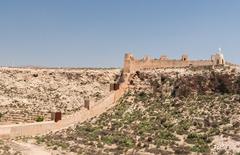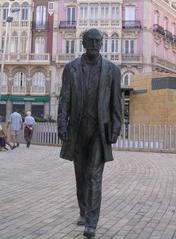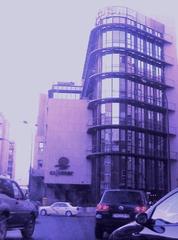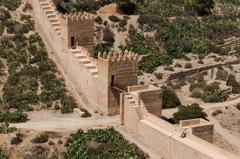Iglesia Catedral De Nuestra Señora De La Encarnación: Complete Visiting Guide, Hours, Tickets, and Essential Tips
Date: 15/06/2025
Introduction
The Iglesia Catedral De Nuestra Señora De La Encarnación—commonly known as Almería Cathedral—is one of Spain’s most unique and historically significant monuments. Located in the heart of Almería’s old town, the cathedral stands out not only for its striking blend of Gothic, Renaissance, Baroque, and Neoclassical styles, but also for its fortress-like features, a response to the turbulent 16th-century history of the city. This guide provides a detailed overview of the cathedral’s history, architecture, visitor information, and practical tips for a rewarding experience.
Historical and Architectural Overview
Origins and Foundation
The site originally hosted Almería’s Great Mosque, a remnant of the city’s Islamic past. Following the Christian reconquest in 1489, the mosque was converted into a church. However, a catastrophic earthquake in 1522 destroyed the earlier structure, prompting construction of a new cathedral beginning in 1524, under Bishop Fray Diego Fernández de Villalán (almediam.org; choose-almeria.com; jdiezaarnal.com).
Fortress-Cathedral Design
Unlike most Spanish cathedrals, Almería Cathedral was conceived as both a house of worship and a defensive stronghold. Its massive stone walls, battlements, arrow slits, and flat roof—originally intended to accommodate cannons—were essential for withstanding pirate raids and internal conflict (andalucia.com; thecrazytourist.com; andalucialovers.com). The fortress-church design makes it the only cathedral in Spain with such pronounced military features.
Stylistic Evolution
Construction spanned over two centuries, resulting in a harmonious blend of architectural styles:
- Gothic Foundations: The floor plan features three naves of equal height and star-shaped ribbed vaults.
- Renaissance Elements: Notable in the main and north façades, with classical pilasters, medallions, and ornamental windows.
- Baroque and Neoclassical Additions: Including the grand Baroque altarpiece, neoclassical cloister, and sacristy.
- Notable Architects: Diego de Siloé, Juan de Orea, and Ventura Rodríguez each contributed to the cathedral’s evolving design (barcelo.com; andaluciarustica.com).
Interior Highlights
Inside, visitors will find:
- The Walnut Choir: A 16th-century masterpiece with 75 intricately carved seats.
- Baroque Altarpiece: Rich woodwork and religious paintings dominate the main altar.
- Sol de Portocarrero: A 16th-century sun emblem carved on the eastern wall, now a symbol of Almería (choose-almeria.com).
- Chapels and Tombs: Including the tomb of Bishop Villalán and notable works such as Joseph Antolínez’s Immaculate Conception (1670).
- Cloister and Sacristy: The neoclassical cloister, once a defensive courtyard, now houses exhibitions and a tranquil garden space.
The Cathedral’s Role in Faith and Community
Almería Cathedral is the seat of the Roman Catholic Diocese of Almería and remains central to the city’s religious life (catedralalmeria.com). The Capilla del Santo Cristo de la Escucha, containing the alabaster tomb of Bishop Villalán, is a site of pilgrimage. Major liturgical celebrations, including Holy Week processions, underscore the building’s ongoing spiritual significance (spain.info).
Visiting Information
Location and Accessibility
- Address: Plaza de la Catedral, 8, Almería
- Public Transport: Bus line M 370 (Fuente De Los Peces stop) connects to the main station in about 11 minutes.
- Parking: No on-site parking; public lots are available within a 10-minute walk (andalucialovers.com).
The cathedral is wheelchair accessible, with ramps at the main entrance, accessible restrooms, and an elevator in the bell tower (inaugurated in 2023) (wikipedia).
Opening Hours
- Tuesday to Sunday: 10:00 AM – 6:00 PM
- Closed Mondays (except public holidays)
- Religious Services: Daily at 09:00 and 19:30. Sightseeing is restricted during Mass (barcelo.com).
Check the official website for seasonal or holiday variations.
Tickets and Admission
- General Admission: €5 (includes audio guide)
- Discounts: Students, seniors, and groups
- Free Entry: Children under 12, EU citizens under 18, local residents
- Special Tours: Guided tours (€11, Fridays/Saturdays), bell tower tours (€5 extra, not wheelchair accessible) (andalucialovers.com; exploredbymarta.com)
Tickets can be purchased on-site at the Museo de la Catedral entrance or online.
Guided Tours and Audioguides
- Guided Tours: Fridays and Saturdays, 11:00 and 16:00, in Spanish with some English explanations.
- Audioguides: Available in multiple languages, included in standard admission.
What to See: Visitor Route
Plaza and Exterior
Admire the crenellated walls, towers, and palm-lined plaza before entering. The ochre stone and lush greenery offer a striking scene for photographs.
Main Nave and Altar
The uniform height of the three naves and the grand Baroque altar create a dramatic interior. Behind the altar lies the funerary chapel and Bishop Villalán’s tomb.
Chapels and Choir
Six chapels, each dedicated to saints or the Virgin, offer sacred art and relics. The walnut choir stalls and twin Baroque organs are highlights.
Cloister and Sacristy
The neoclassical cloister is a peaceful space for reflection, with exhibition rooms displaying religious artifacts and art.
Bell Tower
Guided access only. Over 100 steps lead to panoramic city views—recommended for those able to climb.
Artworks and Symbols
Look for the “Sol de Portocarrero” on the exterior and notable paintings within, including the Immaculate Conception by Joseph Antolínez.
Visitor Services and Practical Tips
- Toilets: Available on site.
- Shop: Religious souvenirs, books, and local crafts.
- Cafés: Many nearby; Café Hierbabuena is recommended for refreshments.
- Photography: Permitted except during services; flash and tripods discouraged.
- Etiquette: Modest dress and silence appreciated in worship areas.
Allow at least one hour for your visit, and consider late afternoon for fewer crowds and beautiful lighting.
Nearby Attractions
- Alcazaba of Almería: An impressive Moorish fortress with panoramic views.
- Museum of Almería: Archaeological treasures from the region.
- Old Town Walks: Explore historic streets, plazas, and local shops.
Educational and Cultural Outreach
The cathedral’s Museo Diocesano (opened 2012) offers rotating exhibitions on religious art and local history. Interactive displays and high-quality visuals enrich the experience, and virtual tours are available online (catedralalmeria.com).
Frequently Asked Questions (FAQ)
Q: What are the current visiting hours?
A: Tuesday–Sunday, 10:00–18:00. Closed Mondays (except holidays).
Q: How do I buy tickets?
A: At the Museo de la Catedral entrance or online. Guided and bell tower tours have additional fees.
Q: Is the cathedral wheelchair accessible?
A: Yes, except for the bell tower.
Q: Is photography allowed?
A: Yes, except during services and in restricted chapels.
Q: Are guided tours available in English?
A: Most are in Spanish, but some English explanations are provided.
Summary and Visit Tips
The Iglesia Catedral De Nuestra Señora De La Encarnación is a singular destination in Almería, merging centuries of faith, art, and defensive architecture. Its fortress-cathedral design, artistic treasures, and central role in the city’s spiritual and cultural life make it a must-visit. Plan ahead for hours and tickets, take advantage of guided tours, and allow time to explore nearby attractions for a complete experience (wikipedia; andalucia.com; catedralalmeria.com).
Call to Action
Download the Audiala app for up-to-date information on visiting hours, ticket booking, guided tours, and special events. Explore our related articles on Almería’s historical sites, and follow us on social media for exclusive content and travel inspiration.
Sources
- La Catedral de Nuestra Señora de la Encarnación, un símbolo de Almería (almediam.org)
- Almería City Guide (choose-almeria.com)
- 15 Best Things to Do in Almería, Spain (thecrazytourist.com)
- Almería Cathedral (andaluciarustica.com)
- Cathedral of Almería (andalucia.com)
- Cathedral of Almería (barcelo.com)
- Catedral de Almería Official Website (catedralalmeria.com)
- Turismo de Almería (turismodealmeria.org)
- Almería Cathedral - Wikipedia
- Visiting Almería: Cathedral of Almería (visiting-almeria.com)
- Andalucía Lovers: Visit Cathedral Encarnación Almería (andalucialovers.com)
- JDiezArnal: History of Almería Cathedral (jdiezarnal.com)
- Andalucia Lovers: Visit Cathedral Incarnation Almeria (andalucialovers.com)
- Explore by Marta: Best Things to Do in Almería (exploredbymarta.com)
- My Little World of Travelling: Things to Do in Almería (mylittleworldoftravelling.com)



